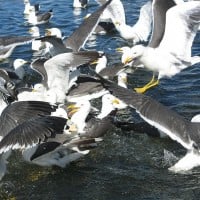Top Ten Most Influential Animals In Human History
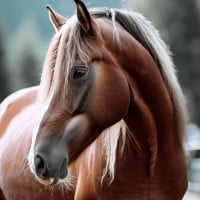 The horse is an odd-toed, hoofed mammal of the taxonomic family Equidae whose sole major subspecies (Equus ferus caballus) is a domesticate, although wild subspecies have survived into the modern period. All subspecies, including the two extant ones, descend from the Pleistocene Equus ferus. The horse... read more
The horse is an odd-toed, hoofed mammal of the taxonomic family Equidae whose sole major subspecies (Equus ferus caballus) is a domesticate, although wild subspecies have survived into the modern period. All subspecies, including the two extant ones, descend from the Pleistocene Equus ferus. The horse... read more Horses are beautiful. They love you no matter what. I also read somewhere that when you meet a horse and they like you, that horse will miss you if you don't come back. They are incredibly humane creatures, and they can actually understand more of the human language than most people think. They are amazing, definitely deserve to be #1.
By far the most important DOMESTIC animal, although mosquitos may indeed have had more actual influence by simply killing people.
The horse was used for war originally, and then for the chariot. They were also a significant part of the Mongol army.
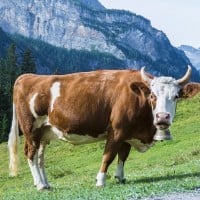 Cattle (Bos taurus) are large, domesticated, cloven-hooved, herbivores. They are a prominent modern member of the subfamily Bovinae and the most widespread species of the genus Bos. Adult females are referred to as cows and adult males are referred to as bulls... read more
Cattle (Bos taurus) are large, domesticated, cloven-hooved, herbivores. They are a prominent modern member of the subfamily Bovinae and the most widespread species of the genus Bos. Adult females are referred to as cows and adult males are referred to as bulls... read more There my favourite animals very useful as well helping humans plow there plants, gives us milk. They also are extremely importent for the rise of capitalism. They were used to carry cargo and were used as trams before the automobile and steam-powered tram were invented. They remain very influential and important for our modern society, and I want science and YOU to make technology to make the cow more influential.
Just say that word aloud to yourself. Cows. What an amazing truth. I mean, you can't argue with that logic.
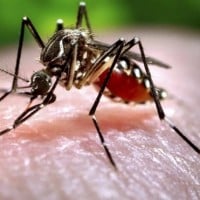 Spanish for "small fly," mosquitoes are insects that have been known to cause various diseases. A sample of diseases caused by mosquitoes: malaria, yellow fever, Chikungunya, West Nile virus, dengue fever, filariasis, Zika virus.
Spanish for "small fly," mosquitoes are insects that have been known to cause various diseases. A sample of diseases caused by mosquitoes: malaria, yellow fever, Chikungunya, West Nile virus, dengue fever, filariasis, Zika virus. Oh these little pests... they are an obstacle to humans. They have carried many diseases such as malaria and West Nile Virus, and helped kill off early European civilizations in America.
Oh Mosquitos! Why do you spend your days sucking blood, making me itch, and spreading malaria!
I think it's the only animal that need to be exterminated in this planet
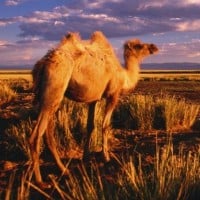 A camel is an even-toed ungulate within the genus Camelus, bearing distinctive fatty deposits known as "humps" on its back.
A camel is an even-toed ungulate within the genus Camelus, bearing distinctive fatty deposits known as "humps" on its back. The camel was used in early attempts to cross the Sahara Desert. The Asian camel could store more water than te African camel, and when used for the first time to attempt the crossing of the Sahara, the man who crossd it, Ibn Battuta found salt deposits and became very wealthy. And when he explored African civilizations, he saw things there such as schools, universities, etc. and when he told Europe about them, this helped Europe exit the Dark Ages.
 The dog or domestic dog (Canis familiaris or Canis lupus familiaris) is a domesticated descendant of the wolf, and is characterized by an upturning tail. The dog is derived from an ancient, extinct wolf, and the modern wolf is the dog's nearest living relative. The dog was the first species to be domesticated,... read more
The dog or domestic dog (Canis familiaris or Canis lupus familiaris) is a domesticated descendant of the wolf, and is characterized by an upturning tail. The dog is derived from an ancient, extinct wolf, and the modern wolf is the dog's nearest living relative. The dog was the first species to be domesticated,... read more These animals light up our days with their cute appearance and their little doggy kisses.
Called man's best friend for a reason. We're so useful to each other.
Without dogs, many of us wouldn't have a reason to live.
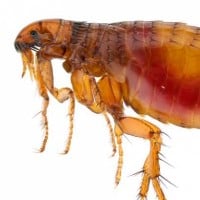 Flea, the common name for the order Siphonaptera, includes 2,500 species of small flightless insects that live as external parasites of mammals and birds. Fleas live by ingesting the blood of their hosts. Adult fleas grow to about 3 millimetres (1⁄8 inch) long, are usually brown, and have bodies that... read more
Flea, the common name for the order Siphonaptera, includes 2,500 species of small flightless insects that live as external parasites of mammals and birds. Fleas live by ingesting the blood of their hosts. Adult fleas grow to about 3 millimetres (1⁄8 inch) long, are usually brown, and have bodies that... read more They spread the Black Death, and that killed off 1/3 of Europe's population.
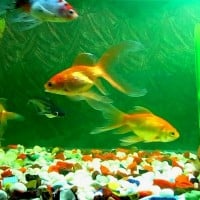
Fish were a very early source of food, and without them, we would have been extinct possibly.
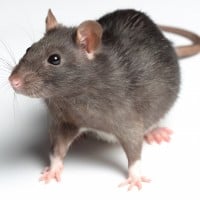 Rats are various medium-sized, long-tailed rodents of the superfamily Muroidea. "True rats" are members of the genus Rattus, the most important of which to humans are the black rat, Rattus rattus, and the brown rat, Rattus norvegicus.
Rats are various medium-sized, long-tailed rodents of the superfamily Muroidea. "True rats" are members of the genus Rattus, the most important of which to humans are the black rat, Rattus rattus, and the brown rat, Rattus norvegicus. They were another animal involved in the spreading of the Black Plague.
 The cat (Felis catus) is a domestic species of small carnivorous mammal.
The cat (Felis catus) is a domestic species of small carnivorous mammal.It is the only domesticated species in the family Felidae and is often referred to as the domestic cat to distinguish it from the wild members of the family. A cat can either be a house cat, a farm cat or a feral cat; the latter... read more
They are another significant pet, and they have influenced most of us at one point or another.
My cat is the only one that can make me happy sometimes.
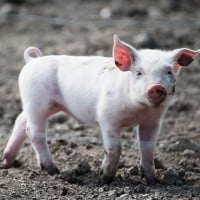 A pig is any of the animals in the genus Sus, within the Suidae family of even-toed ungulates. Pigs include the domestic pig and its ancestor, the common Eurasian wild boar, along with other species; related creatures outside the genus include the peccary, the babirusa, and the warthog.
A pig is any of the animals in the genus Sus, within the Suidae family of even-toed ungulates. Pigs include the domestic pig and its ancestor, the common Eurasian wild boar, along with other species; related creatures outside the genus include the peccary, the babirusa, and the warthog. PIGS! Pigs provide pork, and piglets are so cute
 A rhinoceros, commonly abbreviated to rhino, is a member of any of the five extant species (or numerous extinct species) of odd-toed ungulates in the family Rhinocerotidae. (It can also refer to a member of any of the extinct species of the superfamily Rhinocerotoidea.) Two of the extant species are... read more
A rhinoceros, commonly abbreviated to rhino, is a member of any of the five extant species (or numerous extinct species) of odd-toed ungulates in the family Rhinocerotidae. (It can also refer to a member of any of the extinct species of the superfamily Rhinocerotoidea.) Two of the extant species are... read more They may not be very influential in total, however, they are the main target of poaching, which is a worldwide crisis.
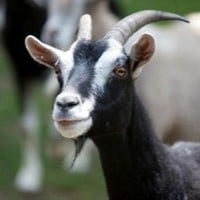 The goat or domestic goat (Capra hircus) is a domesticated species of goat-antelope typically kept as livestock. It was domesticated from the wild goat (C. aegagrus) of Southwest Asia and Eastern Europe. The goat is a member of the animal family Bovidae and the tribe Caprini, meaning it is closely related... read more
The goat or domestic goat (Capra hircus) is a domesticated species of goat-antelope typically kept as livestock. It was domesticated from the wild goat (C. aegagrus) of Southwest Asia and Eastern Europe. The goat is a member of the animal family Bovidae and the tribe Caprini, meaning it is closely related... read more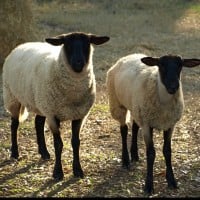 The sheep is a quadrupedal, ruminant mammal typically kept as livestock. Like all ruminants, sheep are members of the order Artiodactyla, the even-toed ungulates.
The sheep is a quadrupedal, ruminant mammal typically kept as livestock. Like all ruminants, sheep are members of the order Artiodactyla, the even-toed ungulates.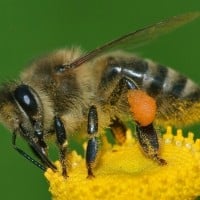
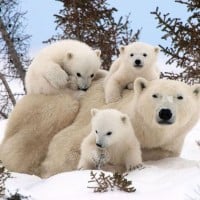 The polar bear is a carnivorous bear whose native range lies largely within the Arctic Circle, encompassing the Arctic Ocean, its surrounding seas and surrounding land masses.
The polar bear is a carnivorous bear whose native range lies largely within the Arctic Circle, encompassing the Arctic Ocean, its surrounding seas and surrounding land masses.
 Owls are birds from the order Strigiformes, which includes over 200 species of mostly solitary and nocturnal birds of prey typified by an upright stance, a large, broad head, binocular vision, binaural hearing, sharp talons, and feathers adapted for silent flight. Exceptions include the diurnal northern... read more
Owls are birds from the order Strigiformes, which includes over 200 species of mostly solitary and nocturnal birds of prey typified by an upright stance, a large, broad head, binocular vision, binaural hearing, sharp talons, and feathers adapted for silent flight. Exceptions include the diurnal northern... read more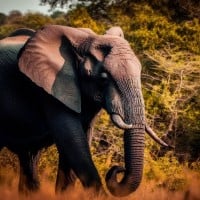 Elephants are the largest existing land animals. Three living species are currently recognised: the African bush elephant, the African forest elephant, and the Asian elephant. They are the only surviving members of the family Elephantidae and the order Proboscidea, extinct relatives include mammoths... read more
Elephants are the largest existing land animals. Three living species are currently recognised: the African bush elephant, the African forest elephant, and the Asian elephant. They are the only surviving members of the family Elephantidae and the order Proboscidea, extinct relatives include mammoths... read more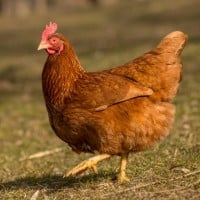 The chicken is a type of domesticated fowl, a subspecies of the red junglefowl. It is one of the most common and widespread domestic animals, with a population of more than 19 billion as of 2011.
The chicken is a type of domesticated fowl, a subspecies of the red junglefowl. It is one of the most common and widespread domestic animals, with a population of more than 19 billion as of 2011. This needs to be higher on the list.
 Zebras (subgenus Hippotigris) are African equines with distinctive black-and-white striped coats. There are three living species: the Grévy's zebra (Equus grevyi), plains zebra (E. quagga), and the mountain zebra (E. zebra). Zebras share the genus Equus with horses and asses, the three groups being... read more
Zebras (subgenus Hippotigris) are African equines with distinctive black-and-white striped coats. There are three living species: the Grévy's zebra (Equus grevyi), plains zebra (E. quagga), and the mountain zebra (E. zebra). Zebras share the genus Equus with horses and asses, the three groups being... read more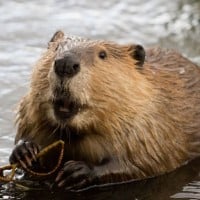 The beaver is a primarily nocturnal, large, semiaquatic rodent. Castor includes two extant species, the North American beaver and Eurasian beaver. Beavers are known for building dams, canals, and lodges.
The beaver is a primarily nocturnal, large, semiaquatic rodent. Castor includes two extant species, the North American beaver and Eurasian beaver. Beavers are known for building dams, canals, and lodges. They were responsible for us expanding out west in america. Fur trappers laid the path for the america we see today. It's hard to imagine an america limited to the east of the plains.
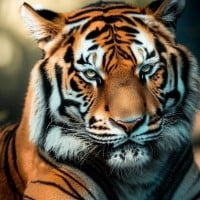 The tiger (Panthera tigris) is the largest living cat species and a member of the genus Panthera. It is most recognisable for its dark vertical stripes on orange fur with a white underside. An apex predator, it primarily preys on ungulates such as deer and wild boar. It is territorial and generally... read more
The tiger (Panthera tigris) is the largest living cat species and a member of the genus Panthera. It is most recognisable for its dark vertical stripes on orange fur with a white underside. An apex predator, it primarily preys on ungulates such as deer and wild boar. It is territorial and generally... read more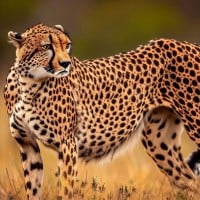 The cheetah (Acinonyx jubatus) is a large cat and native to Africa and central Iran. It is the fastest land animal, estimated to be capable of running at 80 to 128 km/h (50 to 80 mph) with the fastest reliably recorded speeds being 93 and 98 km/h (58 and 61 mph), and as such has several adaptations... read more
The cheetah (Acinonyx jubatus) is a large cat and native to Africa and central Iran. It is the fastest land animal, estimated to be capable of running at 80 to 128 km/h (50 to 80 mph) with the fastest reliably recorded speeds being 93 and 98 km/h (58 and 61 mph), and as such has several adaptations... read more